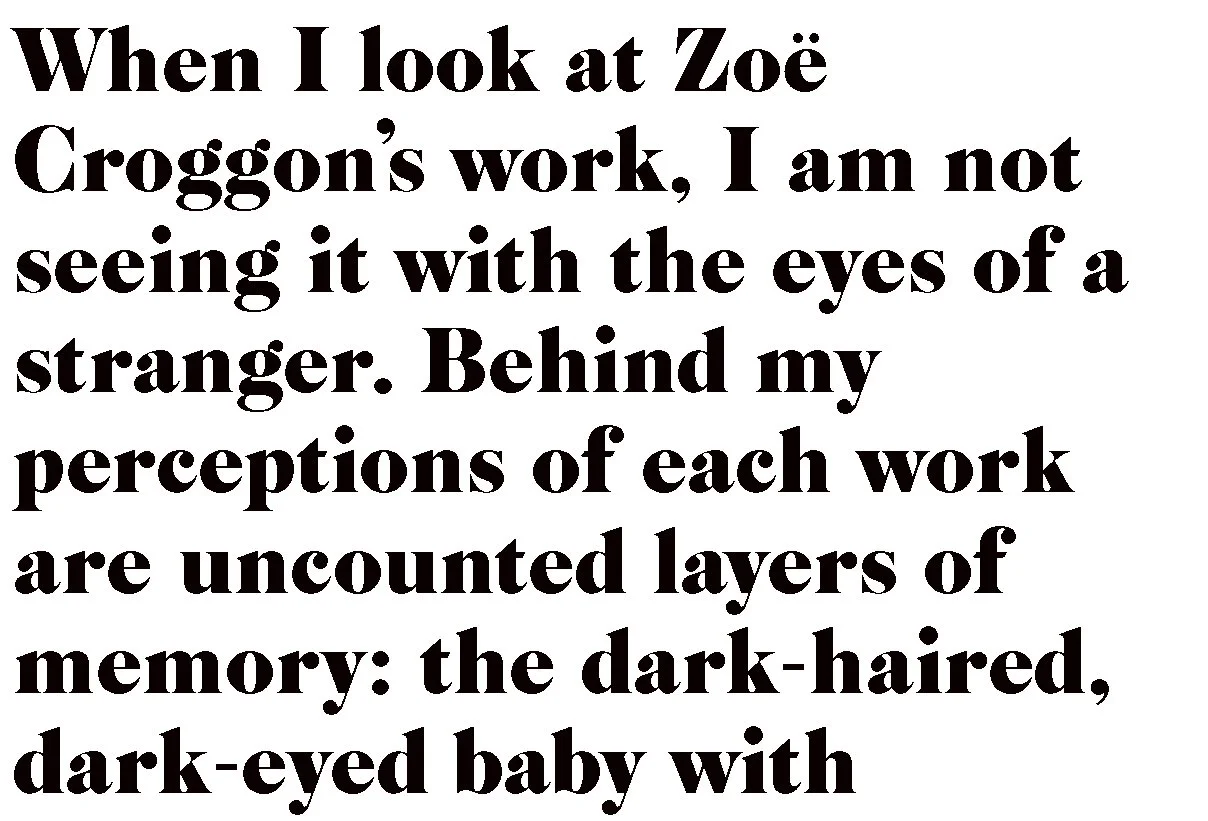Zoë Croggon luce rossa, catalogue essay by Alison Croggon
Art moves, transforming. It changes its methods, but the past does not cease to exist. Art moves using its old vocabulary and reinterpreting old structures and, at the same time, it seems to be static. It changes fast, changes not for the sake of changing, but to impart the sensation of things in their difference through rearrangement.
Bowstring: On the Dissimilarity of the Similar, Viktor Shklovsky
When I look at Zoë Croggon’s work, I am not seeing it with the eyes of a stranger. Behind my perceptions of each work are uncounted layers of memory: the dark-haired, dark-eyed baby with perfectly arched eyebrows, the perversely determined toddler, the adolescent who meticulously wrote in her diary each night, unconsciously employing what Foucault calls the “technologies of the self” in order to construct an identity out of the chaotic possibilities before her.
My looking is a privileged view, informed by a lifetime of watching Zoë grow as a person and as an artist. I can see the logic of her work’s evolution, how the meticulousness and discipline of her chosen form, collage, emerges from so many earlier projects. There’s her fascination with film, in which she is so much more literate than I am. Her attraction to dance. Her magpie hoarding of images. The delicacy and determination with which she searches for a perfect balance between disruption and harmony.
But even all this familiarity doesn’t insulate me against astonishment. I am a writer with almost no visual imagination; my sense of aesthetic stems, rather, from the universes of sound and rhythm. As a young woman, my aesthetic discipline had none of Zoë’s rigor: I was a poet with strong intuitive impulses and almost no idea of how to intellectually shape and contextualise them. Zoë is very different kind of artist to me. Her work also forces me to look as a stranger.
Each new sequence of images – Zoë always works in sequences – introduces a new element to a pallet that is stern and unyielding. She only works in photocollage. She seldom uses more than two or three images. Each sequence employs fragmented images of the human body – dancers, sportspeople or, in the case of luce rossa, images from Italian fashion and pornographic magazines – set against unhuman environments, usually architecture, sometimes landscape. These radically decontextualised, sometimes unrecognisable, sources are transformed into a third image that holds its meanings in dynamic and mysterious tension.
In luce rossa, “red light”, the depersonalisation and fragmentation of pornography is at once intensified and negated. We are given glimpses of bodies – a hand, lips, a breast – set against objects – magazines, fabrics, paper. There is, as always, something disturbing about the violence of the act of collage that is set in tension against the exquisite balances that are achieved in the work.
A distancing sense of classicism in these abstracted bodies exists simultaneously with an invitation to intimacy: the obsessive focus on a limited area of skin, of a hand on a knee, is the kind of glimpse lovers might have of each other. Somehow these visual artworks – artworks, moreover, that are resolutely two-dimensional – invite you into a space that isn’t primarily visual, but tactile. They depend on the rhythms of spatial relationship. In luce rossa there’s a sculptural sense, an insistence on the materiality of these works, that has been increasing since the hand-crafted collages of her sequence Kiri.
“Eros,” says the poet Anne Carson, “is an issue of boundaries….In the interval between reach and grasp, between glance and counterglance…the absent presence of desire comes alive.” In carefully marking and delineating the edges of things, in creating her small but radical shocks of re-contextualisation, Zoë makes an erotics.
Through rearrangement, these images “impart the sensation of things in their difference”. Zoë creates transformations that are charged with mystery, with meanings that seem at once obvious and withheld. The sensuous rhythms of her work are the vibrations of emotional life. By laying bare their artifice as constructed images, these collages invite us into the active thought and feeling that placed these different things together. The familiar is invested with its lost strangeness. And we see it new.

